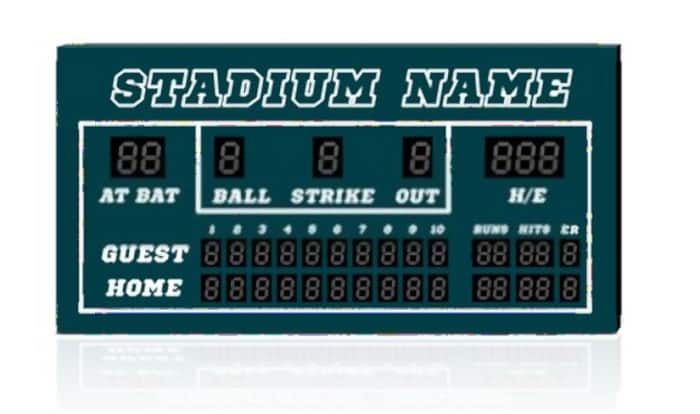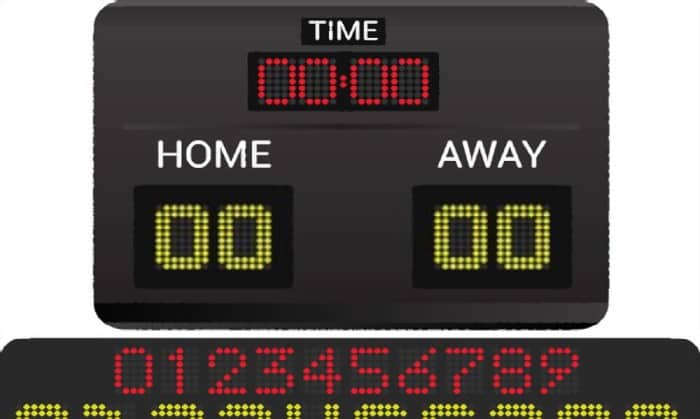Are you about to go to your first baseball game and want to know the basics of reading the scoreboard? Or maybe you need a refresher and need a bit of review for an upcoming game?
The giant scoreboard in the stadium could look intimidating when you are new to the sport. Fret not, because we can show those seemingly random numbers are actually something that will excite your football game.
Well, dig in to know some simple tips on how to read a baseball scoreboard.
Contents
What Is Scoreboard or H/E Baseball Scoreboard
The scoreboard is usually positioned on the middle side of the field and read left to right.
The horizontal numbers 1-9 are used to indicate the innings, and the columns below show the runs in every inning.
The scoreboard is usually operated from a computer system, sometimes via Bluetooth through a mobile phone in a more high-tech setting.
Understand the terms and abbreviations.
Here are the essential terms and abbreviations for a baseball scoreboard explained:
- The number of runs scored each inning – these numbers and stats can be seen in a row beside the team’s names, indicating their total run for each inning.
- R or Total Runs – On the right side of the inning breakdown, you can find the number of runs each team scores in a column on a baseball scoreboard, usually labeled as R.
- H or Total Hits – On the right side of the total runs, a column is usually labeled as H that shows each team’s hits.
- E or Total Errors – On the right side of the total hits, a column is usually labeled as E that shows each team’s errors.
- B or Balls – This indicates the number of balls displayed as they are served or thrown and called by the home plate umpire.
- S or Strikes – This indicates the number of strikes as they are thrown and called by the home plate umpire.
- O or Outs – This indicates how many outs in the innings as the defense does them.
- H/E or Hit/Error Lights – Usually situated near the outs sign, it lights up if the previous play has ruled a hit or if the last play rules an error.
- Guest/Visitor – Indicates the visiting team who traveled to play the game.
- If neither of the two teams traveled in an instance, then the team who batted first will get the visiting role on the scoreboard.
- Home – Represents the team hosting the game.
- If none of the teams get to host the field’s game, then the team who hits second will be considered the host team.
- Innings – This will show the current inning when the game is being played.
Focus on the “guest” and “home” sections.
We will first point out the basic information on the board.
Like the baseball scoreboard on tv, the board is shown linearly and straightforwardly.
This setup helps the players, coaches, and audience quickly go over the game’s score.
But there is usually more to it than what’s on the scoreboard.
First, let us look at “guest” and “home.” Since the visiting team will bat first, they are usually placed above the host team.
This order is not arbitrary since it’s based on the game’s rule that the host team bats last.
This order also helps when you only have to glance to know who’s in the top or bottom of an inning.
The “guest” and “home” are sometimes replaced with the team’s names or logos in some stadiums.
Focus on the horizontal lines to determine the total runs.
Glancing at those horizontal lines, one can see the indicators of the runs.
The total runs are indicated as
- R: total runs
- H: total hits
- E: total errors
- B: balls
- S: strikes
- O: outs
Based on the photo above, the total runs, hits, and errors are indicated on the lower right of the scoreboard. Typically, this is how scoreboards appear.
There will be an electronic scoreboard in other professional games that will display more information than the more simple one above.
There could be information about the player from the previous at-bats or the pitcher’s ERA.
There could also be more batter and pitcher numbers and the speed of the last pitch.
It’s also noteworthy that the Major League Baseball scoreboard is not official as you see it. It will display accurate information about the game, but the official record will be in the scorebook.
Usually, the host team will take charge of the scorebook at youth levels. College or pro levels, on the other hand, will have to hire professionals.
This person will be the one to be consulted when there are disputes about the scores, number of outs, balls, strikes, and others.
Look on the R/H/E line to quickly review what you missed.
The RHE is usually listed after the innings row, indicating each team’s runs, hits, and errors.
Like the innings row, the top will be for the visiting team and the host team at the bottom.
If you miss your team’s game from the previous day and want to know their standing but cannot seem to find it from the baseball scoreboard online, you can do a quick look on the R/H/E line.
Conclusion
While it’s great to familiarize the terms from this article, there will still be nothing compared to witnessing it firsthand in the field. The experience will teach you and make you remember everything about how to read the scoreboard more efficiently.
Knowing how to read a baseball scoreboard will enhance your experience and understanding of the game. It shows how numbers are crucial in this game because it can be easy to lose track when you are in a moment of excitement.

A powerful swing and the ball is flying across the field, just one hit, and we might never forget the thrill it brings. I do not know about you, but I never do. Every baseball game is the chance to compete with others and cooperate with your teammate. It is among my biggest passions.















